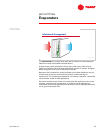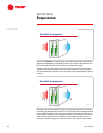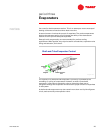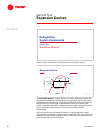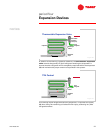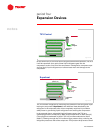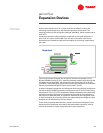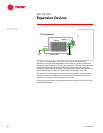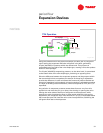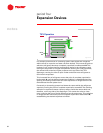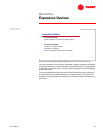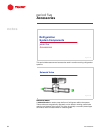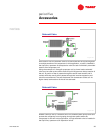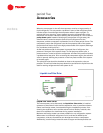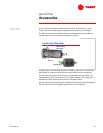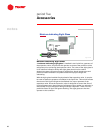
TRG-TRC005-EN 31
period four
Expansion Devices
notes
Using the conditions from the previous example, the 49°F [9.4°C] refrigerant
vapor leaving the evaporator boils the refrigerant in the bulb, generating
97 psia [0.67 MPa] of pressure within the remote bulb. This pressure is
transmitted to the top side of the valve diaphragm, creating a force that pushes
down on the diaphragm.
The 79 psia [0.54 MPa] evaporating pressure, on the other hand, is transmitted
to the bottom side of the valve diaphragm, producing an opposing force.
Since the difference between the evaporator pressure and the pressure within
the remote bulb is due to superheat, the tension of the spring is adjusted to
provide the difference in order to balance the forces and produce the desired
amount of superheat. In this example, the spring tension is adjusted to produce
an 18 psi [0.13 MPa] pressure difference, which corresponds to 12°F [6.7°C] of
superheat.
Any variation in evaporator pressure causes these forces to vary from this
equilibrium and move the pin up or down, thus closing or opening the valve.
Closing the valve reduces the flow of refrigerant to the evaporator, while
opening the valve increases the flow. In other words, with this valve spring
adjustment, the refrigerant vapor must absorb 12°F [6.7°C] of superheat before
the forces that open and close the valve come into equilibrium, stabilizing the
refrigerant flow rate to the evaporator.
TXV Operation
valve pin
valve pin
suction
suction
line
line
spring
spring
49ºF
49ºF
[94ºC]
[94ºC]
79
79
psia
psia
[0.54
[0.54
MPa
MPa
]
]
97
97
psia
psia
[0.67
[0.67
MPa
MPa
]
]
79
79
psia
psia
[0.54
[0.54
MPa
MPa
]
]
18
18
psi
psi
[0.13
[0.13
MPa
MPa
]
]
valve diaphragm
valve diaphragm
Figure 46



